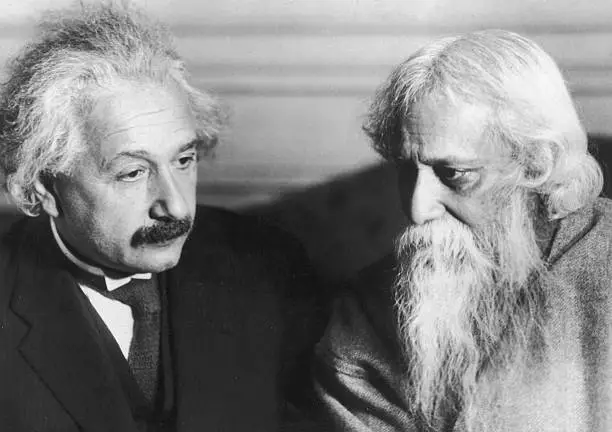(‘Proper teaching must raise curiosity, not explaining things.’)
Dr Leonard Lewisohn notes that ‘although Persian Sufi ideas constitute a significant feature of Tagore’s philosophical and mystical thought, these aspects are generally disregarded by critics of his writings*.
Growing up in a wealthy family, Tagore was raised by servants.
He did not have a formal education. For the most part, he avoided traditional schooling altogether. He learned drawing, anatomy, geography and history, literature, mathematics, Sanskrit, and English by tutoring.
He was also tutored by one of his brothers in physical conditioning such as river swimming, gymnastics and wrestling.
As a young man, he was sent to London to continue his education but returned to India in less than two years.
Later in his life, he said that proper teaching must raise curiosity, not explaining things.
He travelled with his father when he was 12. They left Calcutta in 1873 to tour India for several months, visiting his father’s Santiniketan estate near the Himalayas .
There, Tagore read biographies, studied history, astronomy, modern science, the Indian classical poetry. He refers to his frequent visiting to Golden Temple in this trip with his father .

Sufism and lietrary style
Tagore was not only a poet and dramatist, but a philosopher, painter, musician, composer, and songwriter. He composed more than 2,500 songs,25
He is the author of the national anthems of both India and Bangladesh.
He read the works of Byron, Wordsworth, Keats, and Shelley. He was an admirer of Ralph Waldo Emerson and Walt Whitman. As a writer, Tagore belonged to the generation of Tennyson, Browning, and Robert Bridges, and shared their literary style.
His creative genius characterized as “multidisciplinary creativity,”28 that did not recognize any boundaries; whether those of academic, religious.
He constantly condemned narrow-mindedness in all its manifestations.
Tagore’s work was celebrated by some of the greatest intellectuals, scientists of the time—including W. B. Yeats, Ezra Pound, Romain Rolland, Stefan Zweig, Bertold Brecht, and Count Hermann Keyserling.
He influenced some of Europe’s greatest poets, including Juan Ramón Jiménez32 and, to a lesser extent, Rainer Maria Rilke.33
Nobel prize
He received Nobel Prize for Literature in 1913 for his spiritual lyrical poem called گیتانجالی Gitanjali (Song offerings),
He translated it to English from the original Bengali.
As the first non-European to win the Nobel Prize, Tagore became the most famous literary name of outside the Western world.31

Share the story
Rabindranath Tagore; from avoiding schools to winning the 1913 Literary Nobel Prize– ‘ Proper teaching must raise curiosity, not explaining things’.
Tweet
In this series we will know more about the Rabindranath Tagore family, get familiar with his pedagogy, and the widespread Persian culture of Bengal before the division into East and West Pakistan, and the role of Persian Islam in the Indian reform of Brahmo Samja.
- Hafez and Rabindranath Tagore
- Persian; the language of Bengal until British arrvide in 19th century
- Persian sufism and Indian reform; Ram Mouhan Roy (1772-1833)
- Imam Ali’s followers in a princely family; Rabindranath Tagore
- From avoiding schools to winning the literary Nobel prize
- Calcutta (19th century); the rendevous of Persian poets
- Rabindranath Tagore’s trip to Shiraz to visit Hafez (1932)
- Why did Tagore renounced his Knighthood
- Hungry Stones; an excerpt of a short story by Rabindranath Tagore
- Shiraz 1932; Tagore meditating beside the tomb of Hafez
Suggested readings and references:
Special thanks to Dr Leonard Lewisohn from the University of Exeter for his research that contributed to the main body of this series adaptation. Additional materials were sourced from Professor Emeritus Irfan Habib’s, and Dr Beatrice Teissier’s publications. Sentences showing an asterisk (*) above may be traced to the provided research materials containing over 145 Parsian and English academic references.
- Rabindranath Tagore’s Syncretistic Philosophy and the Persian Sufi Tradition, Leonard Lewisohn, University of Exeter, 2017, Published by Penn State University Press
- TEXTS FROM THE PERSIAN IN LATE EIGHTEENTH-CENTURY INDIA AND BRITAIN: CULTURE OR CONSTRUCT? Beatrice Teissier, Oriental Institute, Oxford, 2009, Published by Taylor & Francis, Ltd.
- Jallianwala Bagh Massacre, Irfan Habib, 2019, Published by Social Scientist
